Ashley Johnson
Primal Series
Click for a larger image
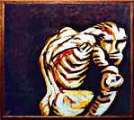 Simian I |
 Simian II |
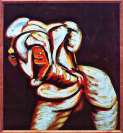 Simian III |
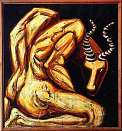 Therianthrope |
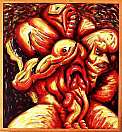 Rut |
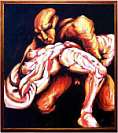 Tranx! |
 Wildebeest Woman |
 Beautiful Beasts |
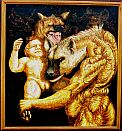 Hyena |
This is a series of eleven acrylic paintings on paper, all 106 x 96 cm, which are thematically linked around the Human/Animal dichotomy. They try to find the animal within the human psyche.
Ancient cultures like the San or Bushman have an interesting concept of the power possessed by animals. This power is called n/um and seems to be an energy that can be beneficial to humanity if controlled or destructive if not channeled. The San perform the Trance Dance, which is a healing ritual, around a fire at night. The women sit in a circle and clap the intricate rhythms of wordless songs that are named after "strong" things like Eland or Gemsbok antelopes. The men dance in a line within the circle and alternate the vortices by changing direction. (This manner of engaging with energy is mirrored in contemporary homeopathic procedures for preparing medicines). Spirit animals are attracted to the dance site. The dancers describe a boiling in their stomachs and begin to see pathways of light that lead to the spirit world. At a point some go into a trance that enables them to blend with the spirit world and in certain cases become spirit animals. This allows them to transcend physical barriers to become shamans. These healers will now physically seek out the "sickness" in the other individuals, drawing it out through sites like belly buttons. Finally, they collapse exhausted and are coaxed back to life by the others through song and stroking.
Conventional Western perceptions of reality have very defined separations between fact and fiction or objects in space. Cultures like the San blur the boundaries between observed reality and the spirit world. They engage with reality using a range of strategies to deceive bad spirits, so for instance a successful hunter will deny hitting his prey and will only modestly admit to scratching it. The purpose is to avoid giving offense to the spirit of the animal killed. Similarly, myths can contain several contradictory stories like an onion with many layers. Reality is in truth a very complex, multi-layered experience.
Recent scientific theories like Quantum Mechanics present a dilemma for Western thought since reality can be described as either particle or wave. The conceptual lexicon is unable to accommodate ambiguity or contradiction. Essentially the entire Western edifice of knowledge is built upon an inadequate understanding of reality. The challenge for this century is to re-synthesize perception. We need to understand that we project what we see. We visualize and assign properties to objects and situations according to predetermined cultural decisions. For instance, we emphasize the individual in Western Culture, imagining a body separate from surroundings. The interpenetrating energies at a sub-atomic level would deny that separation. San people experience the spirit world as a manifestation of their reality and do not emphasize individualism. To them the supernatural is real. Scientific theory has yet to find a way of acknowledging or describing these phenomena.
The reason to develop a new way of seeing is to alter our effect on the environment. Instead of seeing a tree we need to see the larger organism. The Individual must relinquish boundaries so that environment merges with self. The San provide an example of a culture that achieves this.
The Primal paintings have been evolving sporadically from these ideas since the 90's. The earlier works tried to find the animal in broad brushstrokes, examples of which are Simians I, II and III, and were not primarily concerned with representation but rather with passages of energy. They are derived from memories of the activities of primates in old-style zoos but with humans transposed into the forms. Therianthrope is inspired by San ideas of spirit animals whilst Rut reflects on lust and Trans-X relates to transsexuality. Wildebeest Woman is about the deep place women have recourse to during birthing. Beautiful Beasts indulges in erotic fantasy while Hyena questions infant rape, an unfortunate reality of South African society. All the works have an undercurrent of sensuality and movement between states.
These works are a diversion for me from more serious installations like Baboon or Cannibal Communicator: The Congo Holocaust which are combinations of media. Information on these is available at the Dasart website www.geocities.com/dasart.